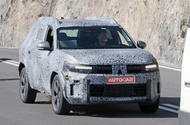Bigster bears a strong resemblance to the Duster, with similar lighting signatures and proportions
Duster’s big brother is headed for showrooms next year with hybrid power and an enticing price tag
Dacia is putting the finishing touches on its largest car to date, the Bigster SUV, ahead of its launch next year.
New images of a camouflaged Bigster testing on public roads suggest that the production car’s design remains largely faithful to the concept unveiled in 2021.
It retains its 4×4-inspired chunky proportions and slim LED headlights, bearing a strong resemblance to the smaller Dacia Duster SUV.
Indeed, the Bigster is effectively a stretched Duster: it’s based on the same Renault Group CMF-B (Common Module Family) platform but at 4.6m in length is 0.3m longer.
This makes the Bigster the Romanian brand’s largest car to date, taking on hot sellers such as the Ford Kuga and Toyota RAV4.
Dacia CEO Denis Le Vot believes that the Bigster’s value-focused approach gives it a chance to capture the attention of car buyers who are steadily being priced out of the mid-sized segment.
Speaking to Autocar last November, he said: “Less than 10 years ago, you bought something for €33,000 [£28,500], and then you go to the same dealership [for your new car] and they say the new car is €40-something thousand. Then lots of people will say: ‘Oh, no, I’m not doing that. It’s too expensive.’ This is where Dacia makes sense, because we’re coming with, in the case of a C-[segment] crossover, the Bigster, and it’s not going to start with a four.”
As such, the Bigster is expected to undercut its key rivals on price, likely starting just below the £30,000 mark. For reference, a new Kuga is £32,095, while the Skoda Kodiaq starts at £36,645. The new Duster is expected to be priced below £20,000.
Le Vot suggested that Dacia would keep prices low by building “the essential car”, omitting unnecessary technologies and equipment where possible.
“We design cars with zero superfluous content: no screen when we can put no screen, no electronics when we can put no electronics, no ADAS when we can put no ADAS,” he said.
He added that “we are taking the assets from the [Renault] Group”, implying that the Bigster’s powertrains will be plucked from existing cars. The entry-level Bigster is anticipated to use the 108bhp turbocharged four-cylinder from the Dacia Jogger MPV, and the 138bhp hybrid set-up deployed in the Jogger and Duster is also expected to be offered.
Although the Bigster will be a five-seater as standard, it is likely that a third row will also be offered as an optional extra, like the similarly-conceived Nissan X-Trail.
The Bigster comes as Dacia reinvents its brand image, going from a maker of ‘cheap’ cars to a bona fide rival for the likes of Jeep – but without abandoning its value-focused principles.
Speaking to Autocar at last year’s Goodwood Festival of Speed, Renault Group design boss Laurens van den Acker explained that chief Luca de Meo wanted Dacia to have “an aspiration beyond affordability”.
In turn, Dacia has sought to capture the more adventure-minded buyer, linking itself to the great outdoors with more overt styling and a range of camping products for its cars.
“In my view, there’s no serious competitor for Jeep in Europe,” said van den Acker. “Why couldn’t Dacia be that? There’s no [affordable] brand that’s linked to the outdoors, that gets you out of town which, especially since the Covid days, is becoming extremely relevant.
“[Dacia] is a brand that’s very well positioned for people who love the outdoors. It gives you two reasons to buy the car, not just one.”







